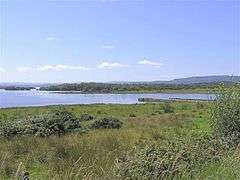
Boa Island
Boa Island (from Irish: Badhbha) is an island near the north shore of Lower Lough Erne in County Fermanagh, Northern Ireland. It is 25 kilometres (15.5 mi) from Enniskillen town.
It is the largest island in Lough Erne, approximately 5 miles (8 km) long, and relatively narrow. The A47 road goes through the length of the island. This road joins each end of the island to the mainland by bridges leading west toward Castle Caldwell and east toward Kesh.
Boa Island features a counterscarp rath (grid ref: H0744 6250) as well as carved stones, graveyard and enclosure (grid ref: H0852 6197), all in Dreenan townland and all Scheduled Historic Monuments. The Lustymore stone figure was moved here in 1939 from the nearby island of that name. The oldest stone monument on the island is a denuded cairn at Inishkeeragh Bridge near the southern tip of the island.
Name of the island
Boa Island is named after Badhbh, sometimes spelled, Badb, the Celtic goddess of war. Badhbh sometimes took the form of a carrion crow, most notably on the shoulder of the warrior, Cúchulainn, after he died in battle. At other times she is depicted as a wolf.
Boa
Boa, BoA, or BOA may refer to:
Snakes
- Any member of the Boinae, a subfamily of boid snakes
- Any member of Boa (genus), a group of boid snakes
- Any member of Boa (genus), a group of boid snakes
Film
Computing
People with the given name Boa

Boa (album)
Boa is the debut album by the Croatian and former Yugoslav eponymous rock band. It was released in 1982.
Track listing
Side A
Side B
External links
Boa (Croatian band)
Boa is a Croatian music group, which was especially prominent during the 1980s around the former SFR Yugoslavia.
History
The band's early history started in Zagreb, then SR Croatia in 1974, when its founding members Mladen Puljiz and Slavko Remenarić, switched their interest from classical music to rock music, inspired by art rock acts such as Yes, King Crimson, Genesis, David Bowie, Roxy Music and Peter Gabriel.
The group started its concert activity in 1979 with a line-up consisted of: Mladen Puljiz (keyboards, vocals), Slavko Remenarić (guitar), Igor Šoštarić (drums) and Damir Košpić (bass guitar). The band moved towards the then actual New Romantic sound and fashion and after the release of their debut album for Suzy in 1982, they were voted by the readers of the prominent Yugoslav musical magazine Džuboks as the best upcoming act of the year.
Their next album Ritam strasti (Rhythm of passion) followed by around a hundred concerts around former Yugoslavia brought them even higher popularity. Despite the fact that their next album Govor tijela (Body language) included some successful hits, the band fell into creative crisis and thus the group halted its activities until 1989 when the group got a new rhythm section consisted of the drummer Paolo Sfeci (former member of Aerodrom and Parni valjak) and the bass player Zvonimir Bučević (prominent session musician).
Podcasts:

-
by Blondie
-
by Blondie
-
by Blondie
-
by Blondie
-
by Blondie
-
by Blondie
-
by Blondie
-
by Blondie
-
by Blondie
-
by Blondie
-
by Blondie
-
by Blondie
-
by Blondie
-
by Blondie
-
by Blondie
-
by Blondie
-
by Blondie
-
by Blondie
-
by Blondie
-
by Blondie
-
by Belinda
-
by Belinda
-
by Belinda
-
by Belinda
-
by Belinda
-
by Belinda
-
by Belinda
-
by Belinda
-
by Belinda
-
by Belinda
-
by Belinda
-
by Belinda
-
by Belinda
-
by Belinda
-
by Belinda
-
by Belinda
-
by Belinda
-
by Belinda
-
by Belinda
-
by Belinda
-
by Belinda
-
by Belinda
-
by Belinda
-
by Belinda
-
by Belinda
-
by Belinda
-
by Belinda
-
by Belinda
-
by Belinda
Le Bleu
by: BlondieLe bleu
(Chris Stein – Gilles Riberolles)
---speculated lyrics---
Amène-toi, Johnny !
Emmène-moi, Johnny !
Tous ces goûts de passé
Ces délices fanés, m’envahissent
Tu le sais !
Je suis un animal avec du bleu à l’âme
Je suis un animal avec du bleu à l’âme
Et nos cœurs face à face envoûtés
L’innocence recommence
Emmène-moi dans la danse, Johnny !
J’ai oublié mon cœur
Dans un aéroport
Est-ce que tu m’aimes encore ?
C’est toujours la même
Vieille rengaine
Mais moi, je t’aime
Je suis un animal avec du bleu à l’âme
Je suis un animal avec du bleu à l’âme
Est-ce que tu le sais, Johnny ?
Envie de toi
Amène-toi, Johnny !
Emmène-moi, Johnny !
Tous ces goûts de passé
Ces délices fanés, m’envahissent
Tu le sais
Je suis un animal avec du bleu à l’âme
Je suis un animal avec du bleu à l’âme
Et nos cœurs face à face envoûtés
L’innocence recommence
Emmène-moi dans la danse, Johnny !
J’ai du fard aux paupières
J’ai du rouge à lèvres
Mais j’ai le bleu en moi
Emmène-moi dans la danse, Johnny !
Je suis un animal avec du bleu à l’âme
Je suis un animal avec du bleu à l’âme
J’ai oublié mon coeur
Dans une gare ou un port
Est-ce que tu le sais, Johnny ?
Latest News for: boa island
Taiwan could send thousands more immigrants to Arizona if this happens | Opinion
iPhone 16e vs. iPhone 15: After testing both, it's clear the iPhone 16e is a ...
- 1
